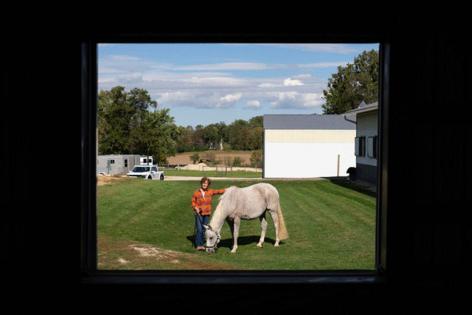'Forage of the future': Minnesota's StableFeed makes horse- and eco-friendly hay
Published in Business News
KASSON, Minn. — There’s a little-known legume that blooms brilliant pink flowers and brings all sorts of benefits to both the soil it grows in and the animals that graze on it.
It’s called sainfoin, and Mary Hartman is building an industry on it.
“This is going to be the forage of the future,” she said.
Hartman’s business, StableFeed, is doing what many governments and universities have tried and failed to accomplish: create a sustainable market for this novel hay that nourishes animals with high protein without causing bloating and acts as a natural de-wormer to boot.
“If we talk about (Hartman’s) biggest hurdle, it’s going to be trying to keep up with the pace of demand,” said Alan Doering, a senior scientist at Minnesota’s Agricultural Utilization Research Institute (AURI).
Hartman originally founded StableFeed in 2017 to sell a homemade chia seed supplement that turned around her horse’s health and is still a strong seller now.
That first year, she had $11,000 in sales.
“I thought, ‘Wow, I have enough to pay for my horse habit,’ ” she said. ”From there, we’ve grown to $1.3 million in sales and profitable for the first time last year."
By the end of the year, StableFeed, now based out of an expanding office and warehouse in Kasson, could approach $2 million in sales.
That’s a fraction of the $4 billion market for horse feed in North America, which giants like Cargill and Land O’Lakes-owned Purina Mills dominate.
But the rapid uptake of Hartman’s natural forage and supplements shows there’s an appetite in the equestrian world for a change to the status quo.
“I think the movement in the horse world is the same as with dogs and cats: We need a species-appropriate diet,” she said. “The whole purpose is to come up with a clean diet: minimally processed whole foods that are proper for a horse.”
Last year, StableFeed won the Naturally Minnesota Pitch Slam, topping other fast-rising food and ag companies and impressing judges. This month, AURI named it Ag Innovator of the Year, a decades-old prize that helps validate a company’s direction.
“There are so many areas she could expand this sainfoin opportunity,” Doering said.
StableFeed’s chia-biscuit business was already taking off in 2018. But after Hartman came across sainfoin, the plant’s potential gripped her.
She went into Doering’s office with a Ziploc bag of seeds, herbs, flowers and sainfoin she wanted to turn into bags of supplemental horse feed. After a few years of development, this “functional food for horses,” as it says on the bag, is now available at specialty retailers around the country, alongside 100% and blended sainfoin forage pellets.
“She knew exactly where she was going to go, and if she ran into hurdles, production or sourcing, she either went around the hurdle or right through it,” said Doering, who helped formulate StableFeed’s sainfoin-based products. “She is driven.”
Hartman’s commitment came from knowing sainfoin could change the way people care for horses and other livestock.
Grown in Europe and Asia for hundreds of years, sainfoin didn’t find much success in the U.S. until about 60 years ago, when new varieties took root. Still, farmers sparsely plant it, and it’s mostly out West.
Economics have held it back: “The large seed, high seeding rate and high seed prices often reduce interest in using this species,” according to a U.S. Department of Agriculture guide to sainfoin.
Sainfoin can fetch a more favorable price for farmers now that buyers like StableFeed are proving there’s a market.
“They used to make $80 or $90 a ton on sainfoin, and I pay them $200 to $220,” Hartman said.
What started as 50 acres of sainfoin to supply StableFeed has grown to 1,500. The crop StableFeed sources is from Montana, though it could thrive in certain Minnesota soils, too.
The self-seeding perennial doesn’t produce as much volume as alfalfa hay, but as a deep-rooted, drought-resistant crop, it’s better for the environment.
“Sainfoin can sit on the landscape for decades,” Doering said. “It’s like a permanent cover crop while also adding value” from honey production. Pollinators like bees love it.
Chia biscuits and sainfoin were a revelation for Hartman’s horse, Monty. A cycle of health issues had trapped the German riding pony. Medicine and traditional supplements weren’t helping.
Monty’s feed ended up being the key.
“Too much ultra-processed food in your diet, or in a horse’s diet, is not healthy,” Hartman said. “Whole foods are always better. Research shows us that.”
Hartman didn’t set out to build a business, but her success with Monty meant other horses might benefit, too. As the success of her chia supplement grew from word of mouth, StableFeed grew from Hartman’s kitchen to her basement to the garage to a dedicated facility in Kasson, not far from where she lives in Rochester.
Sales kept growing as professional riders, mustang trainers and veterinarians helped spread the word in equestrian circles. Now StableFeed has a small staff and marketing budget, as well as sponsorships with riders.
“Making the switch came from seeing the proof in my horses,” said Florida-based event rider Elisa Wallace in a testimonial video.
Hartman can tell when a horse is on StableFeed, which she calls a supplemental food to complement grass and hay. It’s that shiny coat and ideal topline — basically a horse’s posture and muscle build.
But horses might just be the beginning. Because it’s anti-bloat, sainfoin could help reduce gas — and in turn, methane emissions — from cows.
“Sainfoin is highly palatable to sheep and cattle and is preferred over alfalfa,” the USDA guide said.
Before the livestock revolution, Hartman, 63, is focused first on helping sainfoin reach more horse stables and building a dedicated mill in Montana.
“There’s a plant that can improve soil health and also support farmers, clean up the food supply and support pollinators,” she said. “How often as a human being do you have the privilege of being able to be a part of something like that?”
______
©2025 The Minnesota Star Tribune. Visit at startribune.com. Distributed by Tribune Content Agency, LLC.












Comments